| Listing 1 - 10 of 34 | << page >> |
Sort by
|
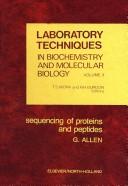
ISBN: 0444802754 9780080858784 0080858783 9780444802750 0444802541 9786611756314 1281756318 9780444802545 0720442001 9780720442007 Year: 1983 Publisher: Amsterdam : Elsevier,
Abstract | Keywords | Export | Availability | Bookmark
 Loading...
Loading...Choose an application
- Reference Manager
- EndNote
- RefWorks (Direct export to RefWorks)
Sequencing of proteins and peptides
Analytical biochemistry --- Amino acid sequence. --- Peptides --- Proteins --- Analysis. --- Aminozuursequenties. --- Analyse. --- Eiwitten. --- Amino acid sequence --- Amino Acid Sequence --- Amino Acid Sequences --- Sequence, Amino Acid --- Sequences, Amino Acid --- Protein Structure, Primary --- Primary Protein Structure --- Primary Protein Structures --- Protein Structures, Primary --- Structure, Primary Protein --- Structures, Primary Protein --- Amino acid sequence analysis --- Analysis, Amino acid sequence --- Peptide sequence --- Peptide sequencing --- Protein sequence --- Protein sequencing --- Sequence, Amino acid --- Amino acids --- Sequence alignment (Bioinformatics) --- Analysis --- analysis
Book
ISBN: 0081012365 0128096764 9780081012369 9780128096765 Year: 2016 Publisher: Amsterdam, [Netherlands] : Academic Press,
Abstract | Keywords | Export | Availability | Bookmark
 Loading...
Loading...Choose an application
- Reference Manager
- EndNote
- RefWorks (Direct export to RefWorks)
Amino acid sequence. --- Proteins --- Protein folding. --- Conformation. --- Chemical warfare. --- Proteids --- Biomolecules --- Polypeptides --- Proteomics --- Folding of proteins --- Protein conformation --- Amino acid sequence analysis --- Analysis, Amino acid sequence --- Peptide sequence --- Peptide sequencing --- Protein sequence --- Protein sequencing --- Sequence, Amino acid --- Amino acids --- Sequence alignment (Bioinformatics) --- Folding --- Conformation --- Analysis
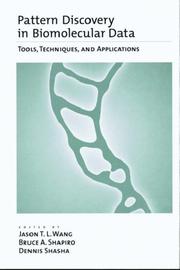
ISBN: 019756125X 1280761679 9786610761678 0198028067 9780198028062 9780195119404 0195119401 0195119401 9781280761676 6610761671 0190283726 Year: 1999 Publisher: New York Oxford University
Abstract | Keywords | Export | Availability | Bookmark
 Loading...
Loading...Choose an application
- Reference Manager
- EndNote
- RefWorks (Direct export to RefWorks)
'Pattern Discovery in Biomolecular Data' presents the work of researchers in the field of pattern discovery, a fundamental operation used in the process of extracting knowledge from biomolecular data. The significant growth of the size of biomolecular data has lead scientists to place increasing importance on developing novel techniques for this knowledge extraction. With this fact in mind, the editors have compiled this clear, up-to-date summary of the principle techniques of pattern discovery in molecular biology, in the hope that readers will build on these techniques and make discoveries of their own.
Nucleotide sequence --- Amino acid sequence --- Pattern recognition systems. --- Information storage and retrieval systems --- Pattern classification systems --- Pattern recognition computers --- Pattern perception --- Computer vision --- Amino acid sequence analysis --- Analysis, Amino acid sequence --- Peptide sequence --- Peptide sequencing --- Protein sequence --- Protein sequencing --- Sequence, Amino acid --- Amino acids --- Proteins --- Sequence alignment (Bioinformatics) --- Data processing. --- Nucleotide sequence. --- Analysis --- Aminoacid sequence
Book
ISBN: 0197560903 9786610451524 0195356837 160256065X 1423735773 1280451521 0198044380 9781423735779 Year: 1994 Publisher: New York Oxford University Press
Abstract | Keywords | Export | Availability | Bookmark
 Loading...
Loading...Choose an application
- Reference Manager
- EndNote
- RefWorks (Direct export to RefWorks)
Computerised sequence analysis is an integral part of biotechnological research, yet many biologists have received no formal training in this important technology. Sequence Analysis Primer offers the beginner the necessary background to enter this vital field and helps more seasoned researchers to fine-tune their approach. It covers basic data manipulation such as homology searches, stem-loop identification, and protein secondary structure prediction, and is compatible with most sequence analysis programs. A detailed example giving steps for characterising a new gene sequence provides users with hands-on experience when combined with their current software.
Nucleotide sequence --- Amino acid sequence --- Amino acid sequence analysis --- Analysis, Amino acid sequence --- Peptide sequence --- Peptide sequencing --- Protein sequence --- Protein sequencing --- Sequence, Amino acid --- Amino acids --- Proteins --- Sequence alignment (Bioinformatics) --- Analysis, Nucleic acid sequence --- Analysis, Nucleotide sequence --- Base sequence (Nucleic acids) --- DNA sequence --- Nucleic acid sequence analysis --- Nucleotide sequence analysis --- RNA sequence --- Sequence, Nucleotide --- Nucleic acids --- Nucleotides --- Methodology. --- Analysis --- Base Sequence. --- Nucleotide sequence.
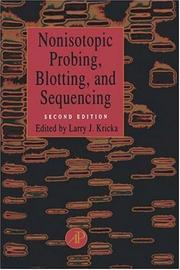
ISBN: 9780124262911 0124262910 9780080537665 0080537669 1281037249 9781281037244 9786611037246 6611037241 9780124262928 0124262929 Year: 1995 Publisher: San Diego : Academic Press,
Abstract | Keywords | Export | Availability | Bookmark
 Loading...
Loading...Choose an application
- Reference Manager
- EndNote
- RefWorks (Direct export to RefWorks)
Since the publication of Nonistopic DNA Probe Techniques in 1992, the move away from radioactive materials for research and diagnostics has continued. This is due in part to public awareness of the hazards of radioactive waste and laws making radioactive disposal more difficult and costly and to improvement in both the sensitivity and convenience of nonisotopic techniques. Several new nonisotopic techniques have been developed and substantial improvements made to existing nonisotopic methods since 1992, and these are now included in Nonisotopic Probing, Blotting, and Sequencing.<
Amino acid sequence. --- Bioluminescence assay. --- Chemiluminescence assay. --- Immunoblotting. --- Molecular probes. --- Nucleotide sequence.
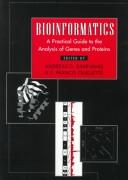
ISBN: 0471324418 0471191965 9780471191964 Year: 1998 Volume: 39 Publisher: New York, N.Y.: Wiley,
Abstract | Keywords | Export | Availability | Bookmark
 Loading...
Loading...Choose an application
- Reference Manager
- EndNote
- RefWorks (Direct export to RefWorks)
Nucleotide sequence --- Amino acid sequence --- Genes --- Proteins --- Séquence nucléotidique --- Séquence des acides aminés --- Gènes --- Protéines --- Databases. --- Data processing --- Analysis --- Data processing. --- Bases de données --- Informatique --- Analyse --- Base Sequence --- Amino Acid Sequence --- Databases, Factual --- Sequence Analysis --- Databases --- analysis --- #TELE:SISTA --- Base Sequence. --- Amino Acid Sequence. --- Amino acid sequence. --- Databases, Factual. --- Sequence Analysis. --- analysis. --- Séquence nucléotidique --- Séquence des acides aminés --- Gènes --- Protéines --- Bases de données --- Nucleotide sequence - Databases --- Amino acid sequence - Databases --- Genes - Analysis - Data processing --- Proteins - Analysis - Data processing --- Proteins - analysis --- MANUALS --- GENE MAPPING --- PROTEIN ANALYSIS --- BIOINFORMATICS --- AMINO ACID SEQUENCE --- PROTEINS --- MOLECULAR BIOLOGY --- GENES --- NUCLEOTIDE SEQUENCE --- COMPUTER TECHNIQUES --- STRUCTURES --- INTERNET --- ANALYSIS --- DATA PROCESSING --- DATABASES
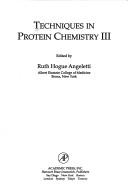
ISSN: 10808914 ISBN: 0127219579 0126820015 0126820007 0127219587 0120587556 0120587564 0120587572 0120587580 0121947106 0121947114 0121947122 0121947130 012473555X 0124735568 0124735576 0124735584 1283608308 9786613920751 9786611466831 1281466832 0080542263 9786611054311 1281054313 008054228X 032314425X 1322054495 1483268225 1322884021 1483259463 1322340463 1483217590 9780080542287 9780124735576 9781281054319 6611054316 9780080542263 9780121947125 9780124735569 9781483217598 9780121947101 9780121947118 9780126820010 9780124735583 Publisher: Academic Press
Abstract | Keywords | Export | Availability | Bookmark
 Loading...
Loading...Choose an application
- Reference Manager
- EndNote
- RefWorks (Direct export to RefWorks)
TECHNIQUES IN PROTEIN CHEMISTRY VI, an invaluable bench-top reference source for protein chemists, highlights current methods in the following areas: Protein sequencing and amino acid analysis Mass spectral analysis of peptides and proteins Posttranslational processing High-sensitivity protein and peptide separations Protein folding and NMR Analysis of protein interactions Protein design and engineeringTechniques in Protein Chemistry VI, an invaluable bench-top reference source for protein chemists, highlights current m
Proteins --- Wetenschappelijke technieken. --- Eiwitten. --- Amino Acid Sequence. --- Biochemistry. --- Analysis --- Analysis. --- analysis. --- Amino acid sequence --- Amino Acid Sequence --- Congresses --- analysis --- Biochemistry --- Health Sciences --- Physiology --- Nucleotide sequence --- -Proteins --- -Reptides --- -Proteids --- Analysis, Nucleic acid sequence --- Analysis, Nucleotide sequence --- Base sequence (Nucleic acids) --- DNA sequence --- Nucleic acid sequence analysis --- Nucleotide sequence analysis --- RNA sequence --- Sequence, Nucleotide --- -Congresses --- Peptides --- Nucleic acids --- Nucleotides --- Sequence alignment (Bioinformatics) --- Organic compounds --- Amino acids --- Nucleotide sequence. --- Biological techniques --- General biochemistry --- Biomolecules --- Polypeptides --- Proteomics --- Proteins - Analysis - Congresses --- Amino acid sequence - Congresses --- Proteins - analysis - congresses --- Amino Acid Sequence - congresses --- SEPARATION --- AMINO ACID SEQUENCE --- PEPTIDES --- MOLECULAR STRUCTURE --- NUCLEAR MAGNETIC RESONANCE --- MASS SPECTROMETRY --- PREPARATION
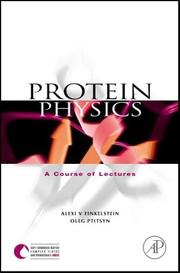
ISBN: 1281005193 9786611005191 0080492185 9780080492186 9780122567810 0122567811 9781281005199 6611005196 Year: 2002 Publisher: Amsterdam Boston Academic Press
Abstract | Keywords | Export | Availability | Bookmark
 Loading...
Loading...Choose an application
- Reference Manager
- EndNote
- RefWorks (Direct export to RefWorks)
Protein Physics is a lively presentation of the most general problems of protein structure, folding and function from the physics and chemistry perspective, based on lectures given by the authors. It deals with fibrous, membrane and, most of all, with the best studied water-soluble globular proteins, in both their native and denatured states. The major aspects of protein physics are covered systematically, physico-chemical properties of polypeptide chains; their secondary structures; tertiary structures of proteins and their classification; conformational transitions in protein molecules and t
Amino acid sequence. --- Protein binding. --- Protein folding. --- Proteins - Structure. --- Proteins. --- Proteins --- Protein binding --- Human Anatomy & Physiology --- Health & Biological Sciences --- Animal Biochemistry --- Structure --- Conformation. --- Chemistry. --- Proteids --- Folding of proteins --- Protein conformation --- Amino acid sequence analysis --- Analysis, Amino acid sequence --- Peptide sequence --- Peptide sequencing --- Protein sequence --- Protein sequencing --- Sequence, Amino acid --- Folding --- Biomolecules --- Polypeptides --- Proteomics --- Amino acids --- Sequence alignment (Bioinformatics) --- Conformation --- Analysis --- Protéines --- Structure. --- Fixation --- ELSEVIER-B EPUB-LIV-FT
Book
ISBN: 9781439810712 1439810710 Year: 2011 Publisher: Boca Raton, FL: CRC,
Abstract | Keywords | Export | Availability | Bookmark
 Loading...
Loading...Choose an application
- Reference Manager
- EndNote
- RefWorks (Direct export to RefWorks)
"The book aims to provide the reader with a detailed description of protein structure and dynamics, combined with an in-depth discussion of the relationship between both these aspects and protein function. Adopting the structural-biophysical approach, we discuss these in relation to molecular interactions and thermodynamic changes that transpire in this highly complex system. There are several types of textbooks describing protein structure and function. Biochemistry textbooks emphasize the functional aspect of proteins and provide a rather general description of structure and structure-function relationship (SFR). Structural Biology textbooks provide an extensive description of protein structure and also refer to SFR with varying degrees of detail. However, energy-related aspects are often avoided. Molecular biophysics textbooks focus on molecular interactions and thermodynamic aspects of protein structure, but tend to lack detailed description of structural and dynamic aspects, as well as SFR. Our book refers to all of the aforementioned aspects and attempts to provide a unified view. Our energy-oriented approach is manifested throughout the book, whether we discuss structure, dynamics or specific functions of proteins. An extensive discussion of the energetics of protein structure is also given in a chapter dedicated to this topic."--
Proteins --- Physical biochemistry --- Amino Acid Sequence --- Protein Conformation --- Structure-activity relationships --- physiology --- 577.122 --- 577.122 Protein metabolism --- Protein metabolism --- Amino Acid Sequences --- Sequence, Amino Acid --- Sequences, Amino Acid --- Protein Structure, Primary --- Primary Protein Structure --- Primary Protein Structures --- Protein Structures, Primary --- Structure, Primary Protein --- Structures, Primary Protein --- Peptides --- Conformation, Protein --- Conformations, Protein --- Protein Conformations --- Protein Folding --- Biophysical chemistry --- Biochemistry --- Physical organic chemistry --- Proteids --- Biomolecules --- Polypeptides --- Proteomics --- Proteins - Structure-activity relationships --- Proteins - physiology
Book
ISBN: 0128119500 0128119136 9780128119501 9780128119136 Year: 2019 Publisher: London, United Kingdom : Academic Press, an imprint of Elsevier,
Abstract | Keywords | Export | Availability | Bookmark
 Loading...
Loading...Choose an application
- Reference Manager
- EndNote
- RefWorks (Direct export to RefWorks)
Protein Modificomics: From Modifications to Clinical Perspectives comprehensively deals with all of the most recent aspects of post-translational modification (PTM) of proteins, including discussions on diseases involving PTMs, such as Alzheimer's, Huntington's, X-linked spinal muscular atrophy-2, aneurysmal bone cyst, angelman syndrome and OFC10. The book also discusses the role PTMs play in plant physiology and the production of medicinally important primary and secondary metabolites. The understanding of PTMs in plants helps us enhance the production of these metabolites without greatly altering the genome, providing robust eukaryotic systems for the production and isolation of desired products without considerable downstream and isolation processes. Provides thorough insights into the posttranslational modifications (PTMs) of proteins in both the plant and animal kingdom. Presents diagrammatic representations of various protein modification and estimation mechanisms in four-colors. Includes coverage of diseases involving posttranslational modifications.--
Proteomics. --- Proteins. --- Protein Processing, Post-Translational. --- Amino Acid Modification, Posttranslational --- Post-Translational Amino Acid Modification --- Post-Translational Modifications --- Post-Translational Protein Processing --- Posttranslational Amino Acid Modification --- Posttranslational Modifications --- Posttranslational Protein Processing --- Protein Processing, Post Translational --- Protein Processing, Posttranslational --- Amino Acid Modification, Post-Translational --- Post-Translational Protein Modification --- Protein Modification, Post-Translational --- Amino Acid Modification, Post Translational --- Modification, Post-Translational --- Modification, Post-Translational Protein --- Modification, Posttranslational --- Modifications, Post-Translational --- Modifications, Post-Translational Protein --- Modifications, Posttranslational --- Post Translational Amino Acid Modification --- Post Translational Modifications --- Post Translational Protein Modification --- Post Translational Protein Processing --- Post-Translational Modification --- Post-Translational Protein Modifications --- Posttranslational Modification --- Processing, Post-Translational Protein --- Processing, Posttranslational Protein --- Protein Modification, Post Translational --- Protein Modifications, Post-Translational --- Glycosylation --- Histone Code --- Metabolic Detoxication, Phase II --- Proteids --- Biomolecules --- Polypeptides --- Proteomics --- Molecular biology --- Proteins --- Post Translational Modification
| Listing 1 - 10 of 34 | << page >> |
Sort by
|

 Search
Search Feedback
Feedback About UniCat
About UniCat  Help
Help News
News